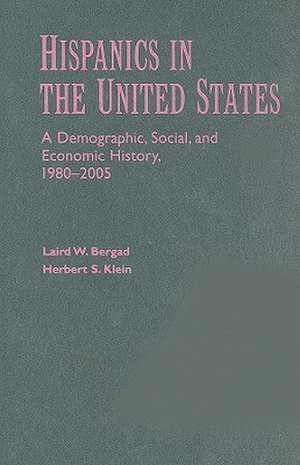Hispanics in the United States: A Demographic, Social, and Economic History, 1980–2005
Autor Laird W. Bergad, Herbert S. Kleinen Limba Engleză Hardback – 8 aug 2010
| Toate formatele și edițiile | Preț | Express |
|---|---|---|
| Paperback (1) | 277.38 lei 6-8 săpt. | |
| Cambridge University Press – 8 aug 2010 | 277.38 lei 6-8 săpt. | |
| Hardback (1) | 432.32 lei 6-8 săpt. | |
| Cambridge University Press – 8 aug 2010 | 432.32 lei 6-8 săpt. |
Preț: 432.32 lei
Preț vechi: 485.75 lei
-11% Nou
Puncte Express: 648
Preț estimativ în valută:
82.74€ • 85.35$ • 70.02£
82.74€ • 85.35$ • 70.02£
Carte tipărită la comandă
Livrare economică 05-19 martie
Preluare comenzi: 021 569.72.76
Specificații
ISBN-13: 9780521889537
ISBN-10: 0521889537
Pagini: 470
Ilustrații: 124 b/w illus. 12 maps 130 tables
Dimensiuni: 152 x 229 x 30 mm
Greutate: 0.39 kg
Editura: Cambridge University Press
Colecția Cambridge University Press
Locul publicării:New York, United States
ISBN-10: 0521889537
Pagini: 470
Ilustrații: 124 b/w illus. 12 maps 130 tables
Dimensiuni: 152 x 229 x 30 mm
Greutate: 0.39 kg
Editura: Cambridge University Press
Colecția Cambridge University Press
Locul publicării:New York, United States
Cuprins
Introduction; 1. Immigration to the United States to 1980; 2. The Hispanic population to 1980; 3. Population growth and dispersion, 1980–2005; 4. The demography of the Hispanic population; 5. Wealth and poverty; 6. Educational attainment; 7. Citizenship, the Latino electorate, and voter participation; 8. Occupational structures, employment, and unemployment; 9. English language abilities and domestic usage; 10. Hispanic business ownership; 11. Race; 12. Endogamous and exogamous marriage patterns among Latino household heads; 13. Conclusion.
Recenzii
"The central, unifying theme of this book is that Hispanics in the United States are an incredibly diverse group about which no easy generalizations can be made. This may sound like a non-finding, but in fact Bergad and Klein elaborate with an impressive wealth of empirical detail just what such diversity means. They explore the diversity of the Latino population along four axes, fundamentally: class (as expressed by income and human capital indicators such as education), geographic location, immigrant status, and gender. The authors have produced, from the raw material provided by U.S. Census databases, an impressive collection of tables, graphs, and maps that illustrate in great detail the demographic history of U.S. Latinos since 1980. This is a remarkable achievement in that it required assembling, processing, and analyzing data from what is sometimes an unfriendly source (the census IPUMS files). The great advantage of this book is that the authors assume no specialized statistical knowledge on the part of the reader. Although, the work which went into generating the knowledge presented in the book evidently required the use of advanced statistical methods, the authors were able to present the data with remarkable clarity and accessibility. Thus, readers from all kinds of fields will benefit from this analysis, not only those with advanced statistical knowledge." – César J. Ayala, University of California, Los Angeles
"Recommended." -Choice
"Recommended." -Choice
Notă biografică
Descriere
This book examines the transformations in the demographic, social, and economic structures of Latino-Americans in the United States between 1980 and 2005.











